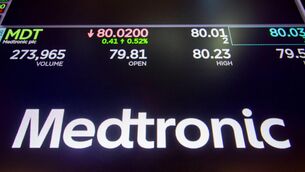David McNamara: Irish jobs market cooling as firms pull back on hiring

The latest labour force survey (LFS) for the third quarter shows annual employment growth decelerated to 1% year-on-year from 2.3% in the second quarter, with nearly 31,000 jobs created in the past year. File photo
The recent exceptional growth in the Irish jobs market looks to have passed, but the apparent chill in the labour market is more nuanced than the headline statistics suggest.
The latest labour force survey (LFS) for the third quarter shows annual employment growth decelerated to 1% year-on-year from 2.3% in the second quarter, with nearly 31,000 jobs created in the past year.
While this recent softening in hiring growth has been well signalled by industry surveys, it is not being accompanied by net job losses, implying a preference of cautious hiring rather than firing by Irish firms.
At a sectoral level, the out-turn was mixed. Of the 14 sub-sectors, nine expanded in the year to Q3 2025. Annual growth was led by a sharp uptick in transport & storage (+16%). Robust gains were also seen in Financial Services (+5%), Industry (+3%), and Education (+3%).
The weakest performers were Information and Communications (-4%), accommodation & food (-4%), and public administration (-7%). Within the construction sector, a notable trend is the continued pivot of the workforce to residential work (+8.5%) at the expense of other non-residential work (-12.4%).
Unemployment remains historically low, but has been grinding higher, and reached 5% in Q3 on a seasonally adjusted basis. That figure is a material revision higher from an initial estimate of 4.7% in the monthly unemployment releases in Q3, but this reflects revisions to growth to the population and labour force base rather than any underlying sharp deterioration in jobless figures.
Indeed, the Live Register showed 166,000 people claiming unemployment benefits in October, a marginal increase of 2,000 (+1%) compared to the same period in 2024.
Instead, it appears the pace of new hiring has slowed, as flagged in the AIB PMI surveys, and this has made the labour market more challenging for new job seekers. In fact, the number of jobless young workers (under 25 years) has ticked up to a greater extent than other age groups over the past year in both the LFS and the Live Register.
This reflects strong population growth in this segment, alongside a potentially more challenging entry-level jobs market. AI could also be a feature, in line with emerging evidence internationally. Admittedly, AI could be one of the key drivers of the sharp employment decline in the tech sector over the past year.
While the jobs data remain positive overall, there are clear signs that this cooling in hiring will continue. The latest hiring data from recruitment website Indeed.ie suggests waning employer demand, with new job postings falling 7% y/y in mid-November.
The AIB PMI employment surveys point to still-solid hiring activity in manufacturing, but services hiring growth has weakened (particularly in tech), alongside signs of caution on the outlook for the next 12 months.
These lead indicators suggest the rapid growth in the jobs market over the past few years has now passed with annual employment growth likely to slow towards 2% for 2025, compared 2.7% in 2024 and 3.4% in 2023.
We expect a further cooling to 1.5-2% in the following years.
- David McNamara is chief economist with AIB












